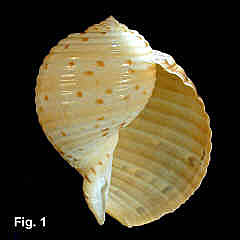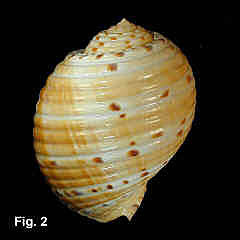|
|
|
|
Tonna cerevisina Hedley, 1919 Description: Shell light in weight in southern specimens, heavier in northern shells; sutures deeply impressed. Scupltured with 17 to 21 primary spiral ribs on the body whorl, sometimes with smaller ribs between the primary ones on the posterior end of the whorl. Colour very variable; at one extreme plain brown or fawn; at the other, cream with some spiral ribs alternating cream and brown. Covered with thin brown pericostracum when alive. Size: Up to 240 mm in length. Distribution: Known from Rockhampton, Qld, to Lakes Entrance, Vic. Also rarely in Fiji, New Caledonia, northern New Zealand and Lord Howe Island. Habitat: Has been collected on intertidal sand flats in Port Hacking but usually trawled down to about 150 metres. Common. Comparison: The two large NSW tuns may be distinguished by colour and shell weight. T. tetracotula is of medium weight, while T. cerevisina in NSW is a very light shell. T. tetracotula is fairly consistent in colour, being plain white or fawn, sometimes with three distinct continuous brown bands, whereas T. cerevisina usually has some spiral rows of brown blotches on the ribs, particularly on the shoulders of the whorls. Remarks: This species is very similar to Tonna variegata (Lamarck, 1822), which, according to Wells & Bryce (1988), occurs from Eucla, WA, through Western and northern Australia to Queensland. Neither species occurs from Lakes Entrance in Victoria through South Australia to Eucla, WA, so the populations are disjunct in southern Australia. There may be a continuous distribution around northern Australia with the two species being western and eastern forms of a single species. Figs. 1,2: SE of Broughton Is., NSW, in 31 fathoms (DLB2482) |

